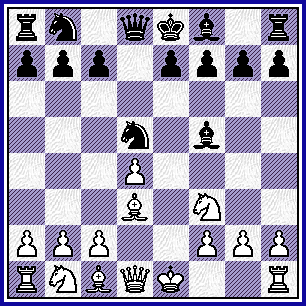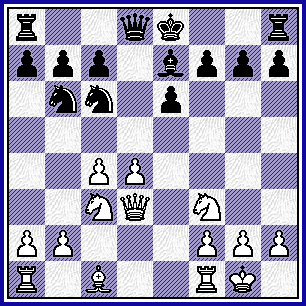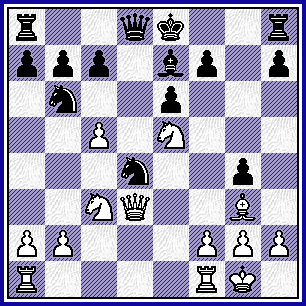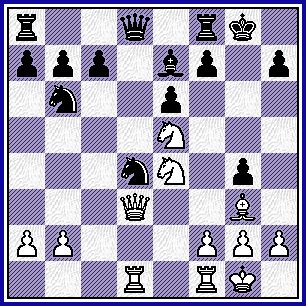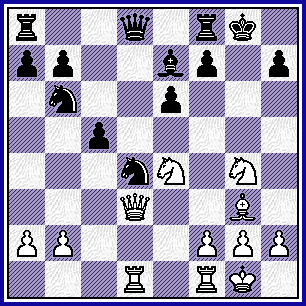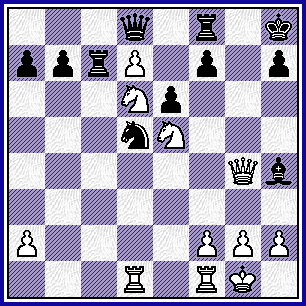GM V. Topalov (2801) - GM G. Kamsky
(2686)
|
|
|
Addendum game for my "GOTM"
website, the June, 2004 column.
(See the main game for full details on the opening.) The source for
this game was TWIC #
584.
The following encounter, is - as I write this - "hot off the presses," so to speak. And since it was a Center-Counter, and also a fascinating, top-level GM game, I knew that I had to add it to this website.
*** *** *** *** *** *** *** *** *** *** *** *** *** *** *** *** *** *** *** *** *** *** *** *** *** *** *** *** *** ***
{The ratings are the ones that were assigned to this game when I down-loaded it off the internet. I cannot check them vs. the FIDE
website, as it is currently
not functioning.}
1.e4 d5;
2.exd5 Nf6;
Perhaps a more sensible move than the traditional 2...QxP/d5.
(For a fairly complete analysis of that line, please see the main game for 06/2004.)
3.Nf3,
A simple developing move. To be honest, I do not think it matters if White plays this or d4 here, probably
the lines will simply transpose.
Please see MCO-14, page # 376; and columns # 04 through # 06 for more details about these complicated lines.
[
According to the reference work, "Modern Chess Openings,"
the following continuation would be considered as the main line:
3.d4 Nxd5; 4.Nf3 g6!?;
This is off the beaten path ... at least it is for me. (I have studied 4...Bg4; in this position.)
However, a close look at the statistics of the "MEGA" database is that this is probably the
main line today.
( For the line that begins with the move of: 4...Bg4!?;
{Diagram?}
please see MCO-14, page # 376;
column # 05, and all notes that
pertain to that column. )
5.c4 Nb6; 6.Nc3,
It is always a good idea to develop!
( Or 6.h3!?, to prevent ...Bg4. )
6...Bg7; 7.c5!? N6d7;
8.Bc4 0-0; 9.0-0 c6;
10.Re1 Nf6;
The end of the column.
11.h3, ('!?')
This is obviously aimed at preventing a pin of the N/f3, but the natural Ne5
was also worth investigation here.
(11.Qe2!?, "+/=" w / some pressure.)
11...b5; 12.Bb3 a5;
13.a3 Na6; 14.Qe2!?,
"+/=" {Diag?}
White has a persistent initiative.
(And a solid advantage.)
GM Nick de Firmian - GM Z. Azmaiparashvili; /
The (FIDE)
Olympiad (tt)
Yerevan, RUS; 1996.
{White won a tough contest, 1-0 in 47 total moves.}
[ See MCO-14, page # 376; column # 04, & note # (s.). ]
************************************************************************************************
White has also played:
3.Bb5+!? Bd7; 4.Be2 Nxd5;
5.d4 Bf5!; 6.Nf3 e6;
7.a3 Be7;
8.c4 Nb6; 9.Be3 0-0;
10.Nc3 Bf6;
"~" {Diagram?}
but Black has a fair game, and is pretty close to equality.
GM Y. Balashov - GM S. Smagin; / Novgorod, RUS; 1995.
[ See MCO-14, page # 376; column # 06, esp. note # (x.). ] ]
3...Nxd5;
4.d4 Bf5;
5.Bd3!?, ('!') {See
the diagram given here - just below.}
White plays to immediately nullify the Black Bishop staring into the heart of the first player's position.
|
|
rn1qkb1r/ppp1pppp/8/3n1b2/3P4/3B1N2/PPP2PPP/RNBQK2R b
While this is good, according to the Fritz PB and the "Mega" database, the move of
5.Be2 is the most popular
play for White in this position.
[
The more traveled path would have to be:
5.Be2 e6; 6.0-0 Be7;
7.a3 0-0; 8.c4 Nb6;
9.Nc3 Nc6; 10.Be3 Bf6; 11.h3 h6; 12.Rc1!,
"~"
when White may have a very small advantage
("+/=") ... due to mostly having a fuzz more space.
(But Black's position is fully playable, and Fritz 8.0 confirms this.)
R. Porkorna - S. Aleksieva; /
The European
(women's) Champ. (R7) /
Bat'umi, GEO; 1999.
{White won a quick victory, but Black's play could be greatly improved - in various places.}
]
Now both sides simply continue to develop in a sensible manner.
5...Bxd3;
6.Qxd3 e6;
7.0-0 Nc6; 8.c4 Nb6; 9.Nc3, "+/=" 9...Be7;
{See
the diagram given - just below.}
Both sides have deployed their pieces in a logical manner out of the opening. White has more space and is ahead in development ... so this
confirms Fritz's evaluation of a solid edge (+0.63) for White.
|
|
r2qk2r/ppp1bppp/1nn1p3/8/2PP4/2NQ1N2/PP3PPP/R1B2RK1 w
This is the one drawback to the this opening system - for Black. White can get a substantial plus by playing simple moves that do not really require any special knowledge of this particular branch of the first phase of a chess game.
10.Bf4!?,
hmmm
A simply way of playing, but one that is also highly effective.
(White hits e5 and also threatens Nb5 in some lines.)
[
The box prefers the simple
10.Be3,
"+/=" {Diag?}
which also yields a solid edge for the first player here.
]
10...g5!?;
(Maybe dubious?)
When I first saw this, I thought that Kamsky had lost his mind, however a close examination of the position at hands reveals that White already has a big edge. (Even if Black plays "normally," Topalov will come out on top.)
[ Or
10...a6;
11.Rfd1 0-0; 12.d5!,
"+/=" (Maybe "+/")
with a big pull and also a powerful initiative for White.
]
11.Bg3!?,
(Maybe - '!')
White stays focused on the center and open lines, apparently Topalov does not care if he gambits a Pawn from this position.
[ Or 11.Be3 g4; 12.Nd2, "+/=" with a nice advantage for White. ]
11...g4!?;
12.Ne5 Nxd4;
IF Black is going to take this Pawn, this looks like the best way of doing it.
[
After the continuation:
</=
12...Qxd4!?;
('?!')
13.Qe2! Qc5;
14.Ne4 Qb4; 15.Nxc6 bxc6; 16.Bxc7,
'±'
White has a large advantage. ]
13.c5!?,
(Maybe - '!')
{See the diagram given - just below.}
Immediately after this game was played, one (USCF) 2000+ player sent me the score of this duel.
He stated that he had watched this game live (on-line), and that this move "was the work of a chess genius" and that "no one had predicted this brilliant play." {He said the move deserved two exclams, at the very least.}
|
|
r2qk2r/ppp1bp1p/1n2p3/2P1N3/3n2p1/2NQ2B1/PP3PPP/R4RK1 b
The move is certainly interesting, and the two-pawn gambit is more than playable by White, and is justified by Kamsky's conduct of this opening. However, White had other methods of playing for an advantage, and they might be just as good (or better) than the path that Topalov chose in this game.
[ Also possible was: (>/=) 13.Rad1 c5; ('[]' ?) 14.Nxg4, '±' with a definite edge for White. ]
13...Bxc5;
(Forced?)
Now this might be the only way that Kamsky can play this position, certainly many of the alternatives (for Black) were far worse.
[ </= 13...Nc8?!; ('?') 14.Qc4!, "+/-" The QR comes to the d-file ... ]
The next few moves (by both sides) are relatively best, ... ...
...
although Nxg4 (on move fifteen) was worth some thought for White.
14.Rad1 0-0;
15.Ne4 Be7; {See the
diagram given below.}
Black's position is disorganized, but it certainly took a lot of courage for GM V. Topalov to sacrifice two
whole pawns in the opening phase!
|
|
r2q1rk1/ppp1bp1p/1n2p3/4N3/3nN1p1/3Q2B1/PP3PPP/3R1RK1 w
Examine this position in detail, once you have worked on it for a while, you will see that White has great play.
How should GM Veselin Topalov proceed from here?
16.Nxg4!,
I like this move, it is certainly the most ambitious try for Topalov.
(If White takes with the Queen on d4, Black exchanges and then regains a piece with ...f7-f5.)
The CB article that covers this round, (http://www.chessbase.com/newsdetail.asp?newsid=2864); gives all of these moves without any comment or annotation.
[ The continuation of:
(</=) 16.Qxd4 Qxd4; 17.Rxd4 f5;
18.Rc1!? fxe4; 19.Rxe4 h5;
20.Ng6,
"+/=" ("+0.22" - Fritz) ...
only yields White a slight edge. ]
16...c5?;
(Really just - '??') {See
the diagram given - just below.}
A terrible move ... that should have lost the game quickly. But I should also point out that this was not a simple blunder, Topalov's energetic play has already forced poor Kamsky into a crisis mode of thinking.
(According to Fritz 8.0, Black should have played
>/= 16...f6[]; or possibly even >/= 16...Nf5!? in this position.)
|
|
r2q1rk1/pp2bp1p/1n2p3/2p5/3nN1N1/3Q2B1/PP3PPP/3R1RK1 w
[
Black should have tried some other
move. But after the continuation of
(say):
>/=
16...Nf5!?;
17.Qc3!! Nd5;
18.Rxd5! , "--->" ("+/-")
{Diagram?}
White probably has a winning attack.
*******************************************************************************************
But Black should probably not try the following variation:
</=
16...f5?!;
17.Nh6+ Kg7[];
18.Be5+ Kxh6;
19.Qh3+ Kg6;
20.Rxd4,
'±' "--->"
when White should win against the greatly
exposed Black King. ]
17.b4?!,
(Maybe just - '?')
Topalov misses the win ... that Garry Kasparov found, while he was following this struggle ... via a telephone!
[
Much better would have been:
>/=
17.Be5! f6;
18.Ng5!! Ne2+;
{Box?}
Fritz seems to 'think' that this is probably forced for Black here.
( Unacceptable would be: </= 18...Nf5?!; ('?') 19.Nh6+ Kh8;
Going to g7 allows a fork on e6.
20.Ngf7+, ("+/-") winning easily for White. )
19.Qxe2 Qe8; Saving one of Black's most valuable pieces.
( But not: </= 19...fxe5?; 20.Rxd8, "+/-" And not: </= 19...fxg5??; 20.Nh6#! )
20.Bc3 e5[]; 21.Ne6,
("+/-")
White is winning easily on material, but at least Black has
managed to avoid
the humiliation of check-mate. ]
I give the rest of the moves without (too much)
written commentary ... ... ...
the game is discussed on the CB
website ...
in some detail.
17...Nd5?; (An error.)
[ >/= 17...Nf5[]; 18.Qf3!, '±' ]
18.bxc5?!, Oooopss!!!
[ Better was: >/= 18.Be5!, (again). ]
18...Nf5; 19.Qf3! Rc8; (19...f6) 20.Bd6!?,
[ (>/=) 20.Bf4!?, '±' (Maybe - '!') ]
20...Nxd6!?;
21.cxd6 Bh4; ('[]' ?)
This is - more than likely - completely forced for Black.
[
Black could
not play:
</=
21...Bxd6?;
22.Rxd5! exd5!?; 23.Ngf6+ Kg7;
24.Qg4+ Kh8;
25.Qh4!,
("+/-") and mates. ]
22.d7 Rc6;
[ 22...Rc2; - Fritz ]
23.Ne5 Rc7?!;
[ >/= 23...Rb6; 24.Rc1!, "+/-" ]
24.Qg4+
Kh8[]; 25.Nd6, "+/-"
and Black decided that this was the appropriate place to tender his (overdue?) resignation.
The final position of the game.
|
|
3q1r1k/pprP1p1p/3Np3/3nN3/6Qb/8/P4PPP/3R1RK1 b
An interesting opening, an extremely complex tactical battle ... yet I think the analysis clearly shows that both sides did not always find the most accurate moves. (Thus decreasing the value of this game as a possible addition to my collection of "short games." {miniatures} At least, IMO.)
Copyright (c) A.J. Goldsby, 2006. All rights reserved.
1 - 0
-
The chess analysis for this feature was prepared with the excellent programs, ChessBase 8.0 and ChessBase 9.0. [purchase]
-
The HTML was generated and refined with several different programs ... then polished for this page with MS FrontPage.
-
The diagrams for this column were prepared with the excellent little program, Chess Captor 2.25.
